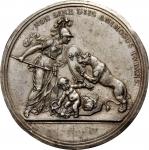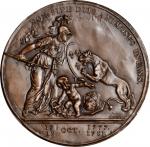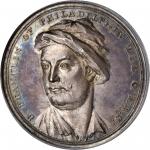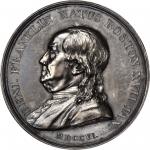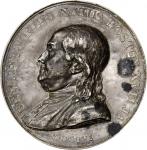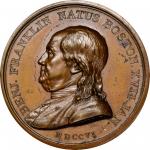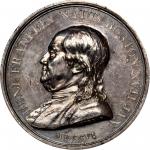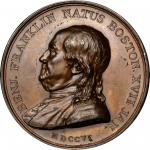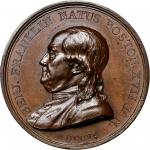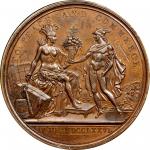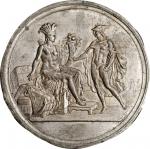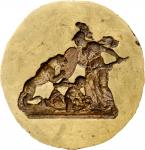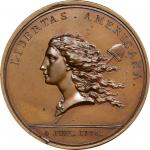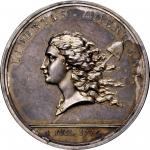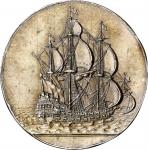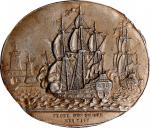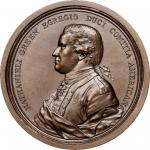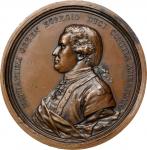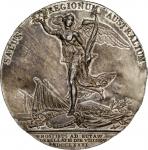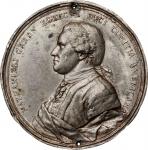1781 (Before January 23, 1783) Libertas Americana Medal reverse cliché. As Betts-615. White metal. Original. Workshop of Augustin Dupre. 43.5 x 43.7 mm., 210.8 grains. 0.7 - 1.1 mm thick. About Uncirculated.Plain trimmed edge. Traces of paper fiber present around periphery of plain back. Medium pewter gray with a faint and pleasing golden tone. Despite the softness of the composition and the relative fragility of this object, the condition is admirable. A minor rim bruise at 6:00 affects nothing, another nearer 5:00 is nearly as minor. Some minor marks are seen, and those on the blank back are just as likely a by-product of the moment of this items production as an injury that has befallen it in the intervening two and a quarter centuries. The color and eye appeal are highly pleasing.<p>The real attraction of this piece is not its beauty but its history. This impression, commonly called a cliché today though referred to by both Franklin and Jefferson as an "éprueve," French for proof, represents a discrete point on the design continuum that preceded the mintage of this, Americas most famous historical medal. The central device appears here in its essentially finished form, but the legends have not yet been punched into the die. Instead, in their place, hand engraved (scratched, in essence) guide lines frame the peripheral legends and the adopted verbiage has been somewhat casually scratched in. The handwriting (i.e., the lightly engraved legends) closely resembles that seen on Dupres preliminary pencil sketches; it is undoubtedly Dupres hand that personally added them to this impression. The position of the main legend is different than that seen on the finished product. On this impression, NON begins just above the tip of Minervas spear. On the final struck medals, NON is located between Minervas flowing back drapery and her helmet. The exergual legend, indicating the dates of the victories at Saratoga and Yorktown, is identical to that found on the struck versions of the medal in terms of both language and layout. Aside from the absence of punched legends, there are a few other notable differences between this proof and the finished product. On the exergual line, DUPRE F. has yet to be punched. The second exergual line, shadowing the bottom side of the main line, has not yet been engraved. One significant difference in the main device is the addition, after this cliché was produced, of cuirass to the breast of Minerva/France. It is a curious change; perhaps Franklin thought France should assume a more warlike posture, or perhaps it was just to evoke better agreement between the dress of the goddess and the tools of war she carried, namely the spear and shield. Another notable difference is that the snakes on this piece show no scaling; the uppermost shows no arrow-tip to its tongue. They are clearly not yet finished.<p>This piece was produced before January 23, 1783, the date of a letter from Alexandre-Theodore Brongniart that included two proofs from Dupre, one of the obverse and one on the reverse. On those clichés, Brongniart notes a misspelling in the main legend NON SINE DIIS ANIMOSUS INFANS, ("en outre le graveur a mis intans au lieu dinfans et quil corrigera ce deffaut dOrtographe"), meaning that the legends had already been placed in the die. The reverse cliché with INFANS spelled INTANS, somewhat miraculously, survives - it was included in our sale of the Ford collection as Lot 286 in Ford XIV. Its significance was missed at the time. That cliché was struck after Minervas cuirass was finished and after the scales had been added to the snakes, thus it represents a later state of the central device than that seen on the presently offered impression. By the same January 23 letter, however, Brongniart requests the final version of the legend "faire ecrire des deux cotes au Bas de la medaille," or to be inscribed on both sides at the base of the metal, in other words, the exergual legends. This cliché shows an exergual legend that matches the final version: perhaps at this point the final decision had not yet been made and other legends were still being considered. In March 1783, Franklin sent an épreuve (singular) to Sir William Jones while noting "the engraving of my medal, which you know was projected before the peace, is but just finished. None are yet struck in hard metal, but will be in a few days." Ready for hardening, the dies of the Libertas Americana medal were by that point complete.<p>This and the lot that follows are the most important of the Libertas Americana cliches, a class that is as sparse as it is important. Aside from the two in this sale, we can account for two others in private hands: Ford:288, the somewhat broken cliche of the finished reverse die, and the framed and inscribed impression from the same finished state of the die that was last sold in our August 2012 sale as lot 4095 (earlier, lot 446 in New Netherlands 36th sale of January 1952, published in <em>The Numismatist</em>, November 1957, and sold in our January 2010 Americana sale as lot 4732). Lot 27 of the 1933 Charles P. Senter sale included a silver and bronze strike of the Libertas Americana medal along with "5 trial pieces." One wonders if the five trial pieces might have included the bronze hub trial above, this cliche, the cliche in the following lot, and the two other cliches known from finished dies - in other words, every single privately held Libertas Americana medal trial known to us. <p>The little known Godefroy Mayer Catalogue 30, issued in Paris in 1913 and fully titled "Old paintings, drawings, miniatures, statuettes, busts, snuff boxes, bonbonnieres, medallions, medals, and other objects of art relating to America," also included Libertas Americana medal cliches. Lot 457 was described as "The same [i.e. Libertas Americana]. Proof impressions in zinc. In two gilt rimmed frames." Lot 458 was "The same. Reverse only. Proof impression in zinc." The current whereabouts of these are unknown. They are not in the collection of the Musee Carnavalet, but these (or similar items) may be in the Musee Blerancourt, where E.A. Gibelins original sketches for the Libertas Americana medal along with a terracotta model of the reverse are among the most prized items in the collection.<p>Every Libertas Americana cliche is able to be dated to the period before the end of March 1783 when Franklin began distributing struck medals. This is clearly the very earliest example of the epreuves, produced less to show the finished design and more to help conceive it. Among all of the Libertas Americana trial pieces in all collections, institutional and private, this piece has no analogue. Perhaps no Libertas Americana cliche can surpass this ones importance.<p><strong>A Note On Trials: Cliches, Epreuves, and Splashers </strong><p><p>The Adams Collection of Comitia Americana and related medals is uniquely enriched by several specimens of a unique form of medallic production that is known by several different names. Typically struck from a die in its earliest state, usually before hardening, these trials were called epreuves - proofs - in the original French correspondence between Dupre and Duvivier and the Founding Fathers charged with the acquisition of the medals the Continental Congress authorized. In more modern numismatic literature, they are more often called cliches or splashers, the latter term being a fair description of just how these trials were made.<p>Unhardened dies are incredibly susceptible to damage, as 18th century die steel (and modern steel today) is brittle before it is hardened by quenching. Once a die is hardened, modification becomes very difficult, so if changes need to be made, they need to be done in that fragile, unhardened state. Engravers in major mints - Paris especially - were accustomed to making soft metal impressions as something of a proofreading copy, enabling the negative die to be viewed in the positive in rough draft form. Wax impressions were liable to leave bits of wax in the interstices of design elements, thus engravers settled upon tin (usually called "white metal" in modern numismatic circles) as the best medium.<p><p>Tin melts at 450 degrees Fahrenheit, a low enough melting point to be accomplished in any small workshop. A ladle full of molten tin poured onto a surface will cool and harden fairly quickly, but remain soft long enough that a die can be easily pushed into it by hand, leaving a relatively durable impression in medal. Most often, medalists would find a piece of scrap paper - a note, a newspaper, a book page - to pour the tin atop, thus preventing their workspace from getting scorched and making the tin sheet somewhat easier to lift and trim. <p><p>These splashers were not intended to be medals, or even permanent, but simply a temporary way to display the state of the die in the positive before its devices were rendered immovable. Each was personally crafted by the engraver in his shop. In the case of the Comitia Americana medals, the epreuves made by Duvivier, Dupre, and Gatteaux were ultimately intended to be viewed and handled by themselves and those close to the process. Benjamin Franklin reviewed the epreuves of the De Fleury medal between April 20 and May 4, 1780, then made recommendations regarding the lettering in the obverse exergue that were adopted by Duvivier. He later did the same with his Libertas Americana medal, correcting a spelling error on the reverse. Engraver Augustin Dupre retained many of his splashers in his personal collection, some of which found their way into institutions in France and the United States, some of which are in the present sale.<p><p>Thomas Jefferson used cliches as a spendthrift (and lightweight) way to collect all the medals of the Comitia Americana series, assembling a set for himself and another for his Virginia countryman James Madison. As he was preparing to depart Paris in September 1789, he wrote to Madison to let him know of the boxes he was shipping, including a box of books and several crates full of Houdons John Paul Jones busts that the sitter wanted to have distributed in America. <p><p><em>I have put a collection of the proofs in tin of the medals voted by the U. S. (except two, of which the dies are in America) the medals themselves not being allowed to be taken, I desired the workmen to let me have two sets of their last proofs; for their manner is, as their work proceeds, to make impressions of it in pure tin, in order to correct &c. These proofs are in fact more delicate than the medals themselves, and the last of them shew the impressions complete. I have had them arranged in a frame, under glass &c. & beg your acceptance of them.</em><p><p>By "delicate," Jefferson did not mean fragile, but well-detailed. The modern whereabouts of these sets are unknown; it is very possible that some proportion of either of these sets are in the current sale.<p><p>Jeffersons set left Monticello in February 1798 in the hands of an enslaved man named York, who Jeffersons son-in-law and overseer, the abusive drunkard Thomas Mann Randolph, called "allmost (sic) an idiot." Randolph told Jefferson that the thief had confessed, listing off an inventory of items from Jeffersons chambers including "some impressions in lead & tin of Dies of the Medals & Coins." He continued "I have some hope of recovering the proofs of Medals (tis from the description I conclude they are out) I have traced one to a Negroe of the neighbourhood who bt. it of York but he says he has lost it." The historical record on the theft and recovery thereafter falls silent; Jefferson wrote several consecutive letters to Randolph after the receipt of this letter but never acknowledged the incident. Two different men named York were enslaved by Jefferson concurrently, one of whom was inherited from the estate of Jeffersons father-in-law in 1774 and described as a "Waterman," the other of whom was born in 1781 and labored at Monticello. Presumably the York involved here was the latter of these two, aged 17 at the time of his act of resistance against Jeffersons authority.<p><p>Today, cliches of each of the Comitia Americana medals are extremely rare, with populations in the low single digits. There is not a single issue in this format that is known to the extent of 8 or 10 pieces. Matched sets of obverse and reverse are the exception rather than the rule. Each of the survivors is an accident, a piece that was made to serve a purpose at a moment in time, not produced for long-term preservation in a cabinet. Their historicity is exceptional, as each survivor was not only in the hands of the medals engraver, but likely in the hands of Thomas Jefferson, Benjamin Franklin, David Humphreys, or a small number of others. Their rarity surpasses that of their normally struck cognates in nearly every circumstance.<p><p>With the possible exception of the Charles Senter Collection, sold at auction in 1933, no cabinet has ever included such a wide array of these historic rarities as the John Adams Collection.<p><strong>The Libertas Americana Medal</strong><p>There is almost nothing we can say about the Libertas Americana medal that has not been said before. It is the most recognizable early American medal, the unanimous choice as #1 in the <em>100 Greatest Medals and Tokens book,</em> and the inspiration for many of the United States coinage designs of the 18th century. It is legendary beyond its rarity, historic beyond its celebrated creation narrative, and important far beyond the world of numismatics.<p>While not properly a part of the Comitia Americana series - it was a medal authorized by Benjamin Franklin as an individual, not the Continental Congress - the Libertas Americana medal has been adopted into this group ever since Thomas Jefferson saw fit to place one in George Washingtons set of Comitia Americana medals in the summer of 1789. By that time, the medal was several years old, as it had been completed and distributed by Franklin in the spring of 1783. Franklin sent his medal far and wide, in France, in the United States, and beyond. His postal accounts show that in April 1783 he twice hired a carriage to special deliver his medal to its recipient. Jefferson had one on display at Monticello, inventoried as "a medal by Dr. Franklin." The Dutch artist Johann-Georg Holtzhey had a friend write to John Adams to ask how he and his friends could obtain one. As the medals found their homes in April and May 1783, Franklins mailbox filled up with thank you notes from across the continent. On April 15 of that year, Franklin sent a bundle of them to Philadelphia to hand out to the members of Congress, including a silver one for Congress president, future Mint Director Elias Boudinot. <p>In September 1783, Franklin wrote to Boudinot "I am happy that both the Device and Workmanship of the Medal are approvd with you, as they have the good Fortune to be by the best Judges on this side the Water. It has been esteemd a well-timed as well as a well-merited Compliment here, and has had good Effects. Since the two first which you mention as received, I have sent by different Opportunities so many as that every Member of Congress might have One. I hope they are come safe to hand by this time." Boudinot confirmed their arrival and described how he parceled them out: "I have received the additional number of Medals, which, not having any particular directions from you, I distributed among the Members of Congress, presented one to the Governor of each State, and the Ministers round Congress."<p>Every Libertas Americana medal was once handled by Franklin, every great American and Frenchman of the era knew about the medal and associated it with Franklin, and every Libertas Americana medal surviving today has a remarkably historic provenance, whether it is fully documented or not.<p>The quoted descriptions of the medal come from the explication published in France in May 1783, quite possibly written by Franklin himself. This explication was printed as a leaflet and intended to accompany the medal itself.<p><strong>Obverse:</strong> "The Head representing American Liberty has its tresses floating in the air, to shew that she is in activity. The Cap carried on a Spear is her Ensign. The Date underneath is that of the Declaration of Independence."<p><strong>Reverse: </strong>"The United States of America are represented by an Infant Hercules, cradled in a Buckler to shew that they are nursed in War. A Leopard, representing England, comes with two serpents to destroy the Infant. France represented by a Minerva, comes armed to his succour, and under her protection he strangles the two serpents, while she guards him from the Leopard, by her shield marked with Fleurs-de-Lis. The Legend is a line of Horace, importing that the Infant was not without divine assistance. The Dates below are those of the two Capitulations of Saratoga & York-Town, whereby two entire English Armies that had enterd and ravaged the United States with fire & sword, were extinguished." In Franklins symbolism, this depiction recalls Hera, the stepmother of Hercules, releasing two snakes to kill Hercules in his cradle; those two snakes were the armies of Burgoyne (defeated at Saratoga) and Cornwallis (defeated at Yorktown).<p>From the John W. Adams Collection. Acquired from our Philadelphia Americana sale, September 2009, lot 6101. Earlier, from our Minot Collection sale, May 2008, lot 518.

